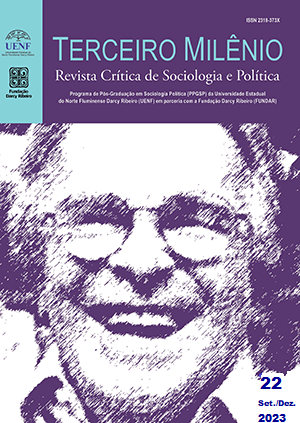Territory and public policies
reflections on the construction of practices capable of influencing the initiative of lethal violence against young people in Brazil
DOI:
https://doi.org/10.59901/2318-373X/v22n3a5Keywords:
Youth, Public policies, TerritoryAbstract
The 2020 Violence Atlas shows that, in 2018 alone, 30,873 young people were victims of homicides in Brazil, which means a rate of 60.4 homicides per 100 thousand young people and 53.3% of the country's total homicides. It is noteworthy that 75.7% of homicide victims were black. When analyzing homicide rates between 2008 and 2018, data from the Violence Atlas also demonstrates that homicide rates increased by 11.5% for black people, while for non-black people there was a decrease of 12.9%. Given the historical persistence of homicides against the black population in Brazil, it is imperative to implement public policies that contribute to the transformation of this reality. Considering my work in the field of public security, especially my work as a technician in leading the implementation of the Fica Vivo! in a location in the city of Belo Horizonte, I seek to present in this article an initial investigation into the interfaces that exist between territory and public policies in the creation of practices capable of influencing the initiative of lethal violence against young people in Brazil. Constituting territorial public policies that address both the conflicts inherent to social coexistence, as well as the duty of the State, the responsibility of everyone and each one in guaranteeing rights is a constant challenge of the work of composition in other ways of coexistence; ways that allow us to glimpse the growing improbability of war and death and, in this way, the daily constitution of a democratic policy aimed at the universal and equitable protection of life.
References
ALONSO, A. (2009). Joaquim Nabuco. In: Botelho, A. e Schwarcz, L. M. (orgs.) Um Enigma Chamado Brasil. São Paulo: Companhia das Letras, pp. 60-73.
ANDRADE, R. C. (1988). Pacto democrático, negociação e autoridade. Lua Nova; Revista de Cultura e Política, São Paulo, n.14, p.7-16, junho.
BEATO FILHO, C.C. (2003). O problema dos homicídios em Belo Horizonte. Revista Brasileira de Ciências Criminais, São Paulo, São Paulo, v.11, n.42, p.345-350, jan./mar.
BORGES DE MELO, D. L; CANO, I. (Org.). (2017). Índice de homicídios na adolescência: IHA 2014. Rio de Janeiro: Observatório de Favelas.
FARIA, L. F. (2006). Uma política de defesa social a céu aberto. Curinga, Belo Horizonte: Escola Brasileira de Psicanálise – Seção Minas, n. 22, p.183-187, jun.
FOUCAULT, M. (1998). História da sexualidade. Rio de Janeiro: Graal.
FOUCAULT, M. (2010). Em defesa da sociedade: curso no Collège de France (1975-1976); tradução de Maria Ermantina Galvão. São Paulo: Martins Fontes.
IPEA & FSB (2020). Atlas da Violência 2020. Instituto de Pesquisa Econômica Aplicada; Fórum Brasileiro de Segurança Pública (Org.). Rio de Janeiro: Ipea; FBSP.
KOGA, D. (2011). Medidas de cidades: entre territórios de vida e territórios vividos. São Paulo: Cortez.
LEGUIL. F. As crianças contumazes. Curinga; Escola Brasileira de Psicanálise – Minas Gerais, v.17, p.138-151.
MBEMBE, A. (2018). Necropolítica. Biopoder, soberania, estado de exceção, política de morte. Traduzido por Renata Santini. São Paulo: n-1 edições.
MINAS GERAIS. (2005). Polícia Militar. Comando-Geral / 3ª Seção do Estado-Maior. Instrução nº. 0002/05-CG. Regula a criação e emprego do Grupo Especializado em Policiamento de Áreas de Risco – GEPAR. Belo Horizonte.
MINAS GERAIS. (2004). Secretaria de Estado de Defesa Social. Plano Estadual de Segurança Pública 2003-2004. Disponível em: < www.seds.mg.gov.br >. Acesso em 10 de outubro de 2004.
NOGUEIRA, M. A. (2010). Nabuco e o pensamento social brasileiro. In. França, H (Org.) Joaquim Nabuco e o novo Brasil.1 ed. Recife: CEPE, v.1, p-41-64.
PNUD BRASIL. (2005). Relatório de desenvolvimento humano – Brasil 2005. Brasília, 2005. Disponível em: <http://www.pnud.org.br/arquivos/brazil_2005_po.pdf>. Acesso em: 14 de agosto de 2023.
SANTOS, M. et al. (2000). Território e sociedade: entrevista com Milton Santos. São Paulo: Fundação Perseu Abramo.
SOARES, L. E. (2011). Temas do pensamento social brasileiro – Segurança Pública. Rio de Janeiro. Disponível em: <http://www.luizeduardosoares.com/?p=136. Acesso em: 14 de agosto de 2023.
WAISELFISZ, J. J. (2013). Mapa da Violência 2013: homicídios e juventude no Brasil. Brasília: Secretaria-Geral da Presidência da República; Secretaria Nacional de Juventude Disponível em: https://flacso.org.br/files/2020/03/mapa2013_homicidios_juventude.pdf. Acesso em: 14 de agosto de 2023.
Downloads
Published
Versions
- 2024-04-24 (2)
- 2024-04-24 (1)


